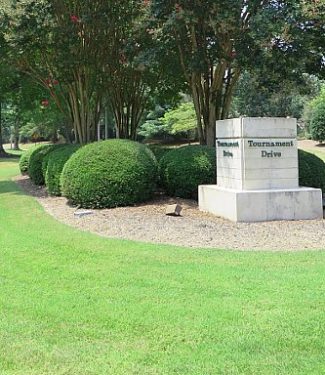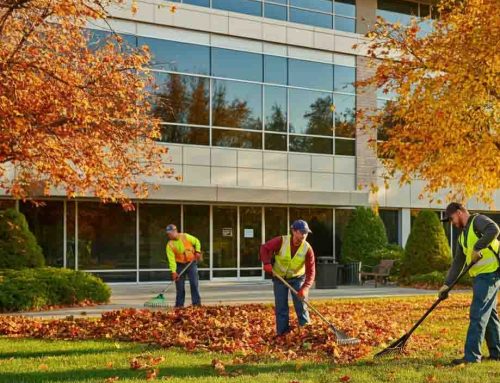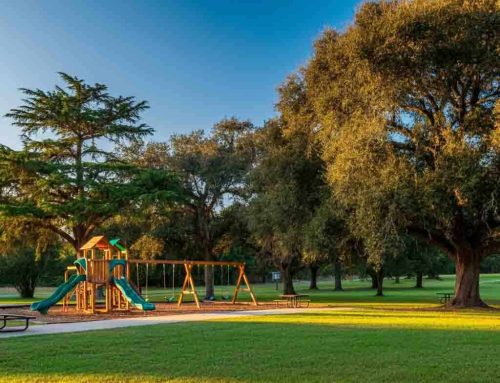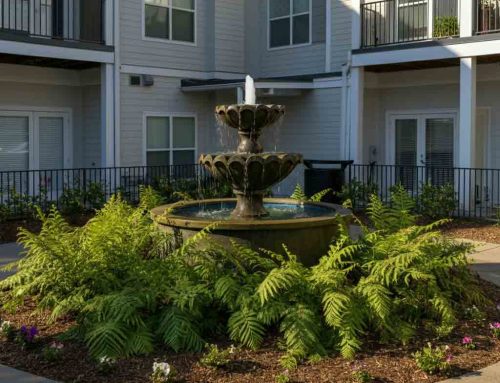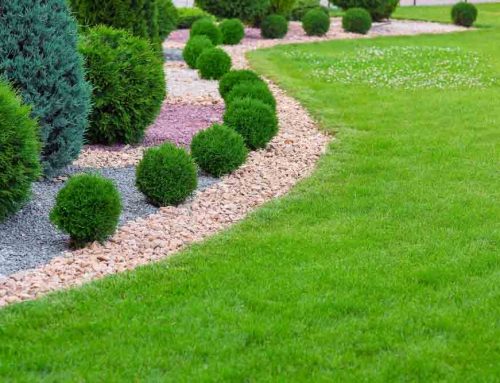Pugh’s Earthworks
Summer can be a challenging season for commercial landscapers, property managers, and lawn care businesses. The extreme heat can wreak havoc on even the most well-maintained lawns, leading to unsightly brown patches and stressed grass. The professionals at Pugh’s Earthworks will guide you through the best practices for Commercial Lawn Summer Heat Care keeping commercial lawns lush and healthy during the scorching summer months. From understanding the impact of heat stress on grass to implementing effective summer lawn care techniques, we have got you covered.
The Science Behind Heat Stress
Heat stress occurs when temperatures rise above what grass can comfortably tolerate. This leads to a range of issues, including wilting, discoloration, and even death of grass blades. High temperatures cause grass to lose water faster than it can absorb, leading to dehydration. Additionally, heat stress can make lawns more susceptible to diseases and pests, further complicating maintenance efforts.
Symptoms of Heat-Stressed Lawns
Recognizing the symptoms of heat stress early can save commercial lawns from permanent damage. Look for signs such as:
- Wilting or drooping grass blades
- Discoloration, including yellow or brown patches
- Increased presence of weeds and pests
- Thinning grass coverage
Common Misconceptions About Heat Stress
Many property managers and landscapers believe that frequent watering can solve all heat-related issues. While hydration is crucial, overwatering can lead to other problems like fungal growth and soil erosion. Understanding the balance between adequate watering and other care techniques is essential for effective summer lawn care.
The Importance of Proper Watering
Optimal Watering Techniques
Watering is the most critical aspect of summer lawn care. It is essential to water deeply and infrequently, allowing moisture to penetrate the soil and reach the roots. Early morning is the best time to water, minimizing evaporation and ensuring that the grass absorbs the maximum amount of water.
- Avoiding Overwatering Pitfalls – Overwatering can be as harmful as under-watering. It can lead to root rot, fungal diseases, and wasted resources. To avoid these pitfalls, use a soil moisture meter to gauge the lawn’s hydration needs accurately. Aim to provide about 1 to 1.5 inches of water per week, adjusting based on rainfall and soil conditions.
- Utilizing Advanced Irrigation Systems – For large commercial properties, traditional watering methods may not be efficient. Consider investing in advanced irrigation systems such as drip irrigation or smart sprinklers. These systems can be programmed to deliver precise amounts of water at optimal times, ensuring even coverage and reducing water waste.
Mowing Strategies for Summer
- Ideal Mowing Heights – Mowing height plays a significant role in maintaining a healthy lawn during summer. Cutting grass too short can expose the soil to direct sunlight, causing it to dry out faster. Aim to keep grass at a height of 3 to 4 inches during the hottest months. This height allows for better moisture retention and provides shade to the soil.
- The Importance of Sharp Blades – Using dull mower blades can damage grass blades, making them more susceptible to heat stress. Ensure that mower blades are sharp to achieve clean cuts, which helps maintain the grass’s overall health. Regularly inspect and sharpen blades throughout the mowing season.
- Adjusting Mowing Frequency – Frequent mowing can stress the lawn, especially during extreme heat. Reduce mowing frequency to once every 7 to 10 days, allowing the grass to recover and maintain its strength. Avoid mowing during peak heat hours to minimize additional stress on the grass.
Fertilization Best Practices
- Timing and Application – Fertilizing during summer requires careful timing and application. Over-fertilization can burn the grass, while under-fertilization can lead to nutrient deficiencies. Apply slow-release fertilizers in early summer to provide a steady supply of nutrients without overwhelming the grass.
- Choosing the Right Fertilizer – Select a fertilizer with a balanced mix of nitrogen, phosphorus, and potassium. Nitrogen promotes healthy growth, phosphorus supports root development, and potassium enhances stress tolerance. Organic fertilizers can also be a great option, providing nutrients without the risk of chemical burns.
- Monitoring Soil Health – Healthy soil is the foundation of a thriving lawn. Conduct regular soil tests to monitor pH levels and nutrient content. Based on the test results, adjust fertilization practices to address any deficiencies or imbalances. Healthy soil ensures that grass can withstand heat stress and other environmental challenges.
Weed and Pest Control
Weeds compete with grass for water, nutrients, and sunlight. Common summer weeds include crabgrass, dandelions, and clover. Regularly inspect lawns for weed growth and take prompt action to prevent them from spreading.
- Effective Weed Management Techniques – Use a combination of manual weeding, herbicides, and cultural practices to manage weeds. Mulching around garden beds and trees can also help suppress weed growth. Pre-emergent herbicides can be applied in early summer to prevent weed seeds from germinating.
- Pest Prevention and Treatment – Heat-stressed lawns are more vulnerable to pests such as grubs, chinch bugs, and sod webworms. Implement integrated pest management (IPM) strategies to keep pest populations in check. IPM includes monitoring, biological control, and minimal use of chemical pesticides.
Aeration and Soil Compaction
Aeration involves perforating the soil with small holes to allow air, water, and nutrients to penetrate the grass roots. This process reduces soil compaction, improves root development, and enhances overall lawn health. Aerate lawns in late spring or early summer for the best results.
- Signs of Soil Compaction – Compacted soil restricts root growth and water infiltration. Signs of soil compaction include water pooling, thin grass coverage, and difficulty inserting a screwdriver into the soil. Regular aeration prevents these issues and promotes a healthy, resilient lawn.
- Aeration Techniques and Tools – For small commercial properties, manual aerators or aeration sandals can be effective. Larger properties may require motorized aerators for efficient coverage. Ensure that the soil is moist before aeration to facilitate easier penetration.
- Addressing Thatch Buildup – Thatch is a layer of dead grass, roots, and organic matter that accumulates between the soil and the living grass blades. While a thin layer of thatch can be beneficial, excessive buildup can hinder water and nutrient absorption, leading to heat stress.
- Detecting and Measuring Thatch – To assess thatch levels, use a garden trowel to dig a small section of the lawn. Measure the thickness of the thatch layer. If it exceeds half an inch, it’s time to take action. Excessive thatch can cause water runoff and create an environment conducive to pests and diseases.
- Dethatching Methods – Dethatching can be done manually with a rake or using specialized dethatching equipment. For severe thatch buildup, consider power raking or vertical mowing. Follow dethatching with aeration and overseeding to promote healthy grass growth.
- The Role of Mulching – Leaving grass clippings on the lawn after mowing can provide several benefits. Clippings act as natural mulch, retaining moisture and returning valuable nutrients to the soil. This practice reduces the need for additional fertilizers and helps maintain a healthy lawn.
- Proper Mulching Techniques – To effectively mulch with grass clippings, ensure that the grass is dry and that clippings are evenly distributed. Avoid mulching when the grass is wet, as this can lead to clumping and thatch buildup. Use a mulching mower to finely chop clippings for better decomposition.
- Alternative Mulching Materials – In addition to grass clippings, other organic materials such as compost, straw, and wood chips can be used for mulching. These materials provide similar benefits, including moisture retention, weed suppression, and soil enrichment. Apply a thin layer of mulch around garden beds and trees to enhance their appearance and health.
Preparing for Extreme Heat Events
- Creating a Contingency Plan – Extreme heat events can occur unexpectedly, posing a significant threat to commercial lawns. Develop a contingency plan that includes increased watering schedules, temporary shade structures, and emergency pest treatments. Having a plan in place ensures a quick response to protect the lawn.
- Temporary Shade Solutions – Shade can provide relief to heat-stressed lawns. Use temporary structures such as shade cloths, tents, or umbrellas to protect vulnerable areas from direct sunlight. These solutions are particularly useful for newly seeded or transplanted grass.
- Emergency Watering Techniques – During extreme heat, supplemental watering may be necessary. Use soaker hoses or sprinklers to provide deep and consistent hydration. Water during the early morning or late evening to minimize evaporation and maximize water absorption.
- Enhancing Soil Nutrients – Soil amendments improve soil structure, fertility, and water retention capabilities. Common amendments include compost, peat moss, and biochar. Incorporate these materials into the soil to enhance its ability to support healthy grass growth.
- Organic vs. Synthetic Amendments – Organic amendments such as compost and manure provide long-term benefits by enriching the soil with organic matter. Synthetic amendments, including chemical fertilizers, offer immediate nutrient boosts. A balanced approach using both types can yield the best results.
- Regular Soil Testing – Conduct soil tests every 2 to 3 years to monitor nutrient levels and pH balance. Based on the test results, adjust your soil amendment practices addressing any deficiencies or imbalances. Healthy soil lays the foundation for a resilient lawn that can withstand summer heat.
- Promoting Healthy Root Systems – Encouraging deep root growth enhances the grass’s ability to access water and nutrients. Deep watering, aeration, and proper fertilization promote robust root systems that can withstand heat stress. Deep roots also improve the lawn’s drought tolerance.
Avoiding Shallow Rooting
Shallow rooting occurs when grass is frequently watered with small amounts of water. This makes the lawn more susceptible to heat stress and drought conditions. Instead, focus on infrequent, deep watering to encourage roots to grow deeper into the soil.
Seasonal Root Care
Root care is not limited to the summer months. Take proactive measures throughout the year to maintain healthy roots. Aerate and fertilize in the spring and fall and avoid heavy foot traffic on the lawn during winter months to prevent soil compaction.
Conclusion
Maintaining a lush, green lawn during the summer months requires a combination of proper watering, mowing, fertilization, and preventive measures. By understanding the impact of heat stress on grass and implementing effective summer lawn care techniques, commercial landscapers, property managers, and lawn care businesses can ensure their lawns remain resilient and vibrant. Remember, a healthy lawn not only enhances the aesthetic appeal of a commercial property but also contributes to its overall value. For more personalized advice and tips, please consider consulting Pugh’s Earthworks lawn care experts and professionals for Commercial Lawn Summer Heat Care and all of your Commercial Landscaping Needs.
Pugh’s Earthworks Commercial Lawn Summer Heat Care
We provide landscaping and lawn maintenance programs for HOA (homeowners associations) and COA (condominium associations). In fact, the work we do for HOA’s and COA’s represents a sizable portion of the more than 300 commercial landscape maintenance clients we serve. Many of those customers have opted for our comprehensive ground’s maintenance service.
Property managers, HOA and COA board members face a unique set of challenges each day. They serve a huge customer base, who really want to live in communities that are well kept and desirable. Our team has a thorough understanding of those challenges. We work closely with our property managers to turn these challenges into opportunities. That allows the property management firms we serve to focus on aspects, other than landscape related. Our job is to make their job easier.
Experience has taught us that every property is different. Our team will focus on the details. We work closely with our clients and customize our commercial landscape maintenance solutions to meet their specific needs.
Landscape Design is an art that has been practiced by people for thousands of years. The earliest known depiction of landscape design was found on the walls of the tomb of Kha and Merit, two Egyptian nobles who lived about 3200 B.C. Landscape designers have since evolved from simply creating gardens to creating entire outdoor environments that enhance homes, businesses and other properties. Today’s landscape designers are more than artists – they are problem solvers who draw upon their creative talents as well as their knowledge of science and technology to create beautiful outdoor areas with minimal environmental impact. Pugh’s Earthworks is a commercial landscape design and installation company that has been in business since 1992. The commercial landscape design team at Pugh’s Earthworks will create a unique design for your property that you can be proud of.”
Pugh’s Earthworks COA & HOA Commercial Landscaping
Pugh’s Earthworks
Memphis Headquarters
Phone: (866) 207-4734


